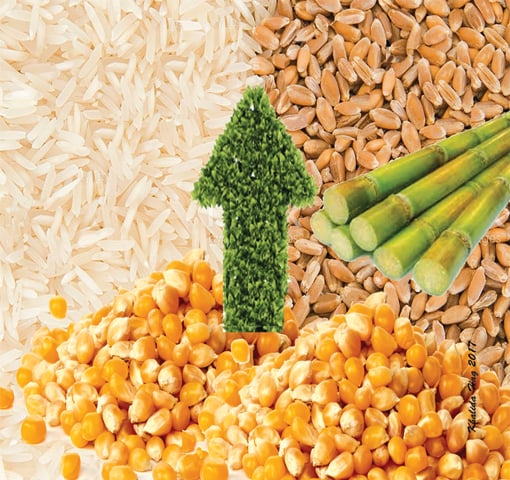
ALL major food crops are doing well at the same time after a gap of many years. The trend could be sustained by investing more in conducting production and productivity research.
According to the latest brief of the Ministry of National Food Security and Research, the output of wheat, rice, sugarcane and maize increased in the outgoing crop year despite water shortage.
Two factors have been driving the production of key crops. First, more land is being brought under cultivation of these crops, and second, their yields are also rising, thanks to the development of new seed varieties in the recent past and the adoption of better farming techniques, food ministry officials say.
Exporters say we must have a larger base of surplus of grains to give an immediate boost to food exports in the near future alongside working on accelerating value-addition
That is why the Federal Committee on Agriculture (FCA) has set higher production targets for major and minor Rabi food crops for 2017-18, despite having factored in the possible negative impact of water shortage.
During a recent meeting, the FCA noted that in the 2017-18 crop calendar the output of rice, sugarcane and maize has been estimated at 7.3 million tonnes, 81.4m tonnes and 5.3m tonnes, respectively.
According to FCA sources, a measured increase in the area under cultivation of the above crops and a scientifically projected rise in yields have formed the basis for the above output projections that are higher than their actual production in 2016-17, except in case of maize.
They say that in 2017-18, per-hectare yields of rice and sugarcane have been estimated at 2.53m tonnes and 62m tonnes, up from 2.51m tonnes and 60.48m tonnes in 2016-17. However, the yield for maize crop has been projected to fall slightly to 4.27m tonnes per hectare next year from 4.59m tonnes this year.
The hopes for higher yields of rice and sugarcane are not misplaced, as during the past few years, some high-yielding new varieties of paddy and sugarcane have become popular among growers.
On the other hand, a rather cautious projection has been made about maize yield as no breakthrough has been recorded of late regarding the development of maize seed variety. Its production hit an all-time high of 6.13m tonnes in 2016-17 largely due to a big increase in the area under cultivation at the cost of wheat.
However, wheat output recorded a modest 0.5 per cent rise in 2016-17 despite shrinkage in the area under sowing, as its per-hectare yield went up due to the use of high-yield varieties and improvement in ways of wheat farming.
The FCA has fixed wheat production target for 2017-18 at 26.46m tonnes, up from 25.75m tonnes in 2016-17. The production target has been fixed higher purely on the basis of an increase in the yield as the area under cultivation for wheat is expected to shrink marginally to 8.95m hectares during 2017-18 from 9.05m hectares in 2016-17.

Authorities expect that the national average yield of wheat would be to 2.96m tonnes per hectare next year, up from 2.84m tonnes in this year.
Per-hectare national average yields of major food crops in Pakistan have shown a modest increase in the past five years, but are still lower than what they could be given the potential of the seeds.
In other words, yield gaps exist and need to be boosted year after year to ensure a certain level of production without expanding the areas under these crops, officials and farmers say.
The desired levels of food crop outputs are determined not only by keeping the growth rate of population (2.4pc per year between 1998 and 2017) but also in view of growing needs of the export sector.
It is true that exporting value-added food products should be made a priority to fetch higher per-unit value of exports. But we must have a larger base of exportable surplus of food grains to give an immediate boost to food exports in the near future alongside working on accelerating the process of value-addition, exporters of food grains say.
On the other hand, given the importance of minor crops both from the viewpoint of domestic consumption as well as exports, these crops, too, cannot be sacrificed for promoting our main food crops, they say.
This means, there is not much scope for increasing the aggregate area under cultivation of key food crops — at least in the near future (unless additional non-cultivable land is made arable on a wide scale).
That leaves us with just a few options: invest more in scientific research projects in search of better, high-yielding, weather-resistant, less water-consuming varieties of food crop seeds; continue to modernise agriculture in terms of use of latest machinery and technology to cut pre- and post-harvest losses; and develop better storage and transportation facilities and exclusive clusters of grain markets.
Officials of the food ministry say the recently introduced National Food Policy covers all these aspects, and the federal government is committed to ensuring sustainability of growth in crops sector.
Meanwhile, provincial governments of Sindh and Punjab are also working, on their own as well as in close coordination of the World Bank, on agricultural farm growth sustainability projects. “Hopefully, not only higher output targets (of major food crops set for 2017-18) would be met, we’ll also be able to maintain a constant growth in the years to come,” an FCA member tells this writer.
Published in Dawn, The Business and Finance Weekly, October 23rd, 2017













































